When your eyes are placed behind normal
prescription glasses, you fall into a trap where you
no longer use the focusing muscles in your eyes to the
fullest. This important ciliary muscle begins to weaken,
requiring visits to your eye doctor for stronger and
stronger glasses. You can reverse this downhill slide
and help develop your eye muscles.

Are you suffering
from
1) Aging Vision
2) Nearsightedness
3) Astigmatism
4) Farsightedness
Wearing Glasses and/or Contacts
Some highly respected doctors have stated
the following about the continued use of glasses and
contacts:
"The emphasis on compensatory lenses
has posed a problem for many years in our examinations.
These lenses do not correct anything and may not serve
the patient in his best interests over a period of time." --CJ.
Forkiortis, OEP Curriculum
"Single-vision minus lenses for full-time
use produce accommodative insufficiency associated with
additional symptoms until the patient gets used to the
lens. This is usually accompanied by a further increase
in myopia and the cycle begins anew." --M.H. Birnbaum,
Review of Optometry.

"Does
wearing glasses really affect the your eyes?
Shockingly, there is ample scientific evidence
that lenses fitted on young primates affects the development
of their eyes.
In research at a New York University, biologists
have demonstrated that wearing a minus lens actually
causes the elongation of the eyeball, in other words
it causes near sight to deteriorate. The same is the
case with plus lenses fitted for presbyopia or far sight.
This research into emmetropization, the eyes' natural
ability to develop clear vision, goes back to the early
1990s."
Of course the idea that glasses make your
vision worse is resisted by the optic industry. Just
as tobacco smoking is not considered harmful by the tobacco
companies.
Now, glasses are a great fix for many people,
but the fact is they are a crutch. Glasses do not repair
your vision. They simply put a band-aid over the condition.
"I just recently received my first pair
of eyeglasses. My eye doctor stated that contrary
to popular belief, that wearing the glasses will
not weaken my eyes any further. However my sister-in-law
went to her eye doctor just last week where her
doctor said the exact opposite, that she was wearing
her glasses too much, which caused her eyes to
weaken" Who do you believe?

|
Have you
ever gone in for an eye-exam and had the doctor say: "great
news, your vision improved another 2 diopters.
Looks like you need a lower prescription." I didn't
think so!
Most people do not question the widely
held assumption that donning glasses is the best thing
that can be done for their eyesight problems. Very few
people take time to consider what really happens when
they put their glasses on, and why this is not the best
solution.
The optics
of glasses
Vision is not static. Your eyesight is
in a constant state of change. This is a fact that most
people are familiar with. For instance all of us have
felt our eyes becoming tired after a long day in front
of the computer.
Glasses are fitted in order to correct
refractive error. In other words, the lens is supposed
to focus the image that we see precisely onto the retina.
However, glasses compensate for the refractive error
in an unflexible way. When worn, the particular level
of refractive error must be constantly maintained in
order for you to be able to see through them.
"The American Optometric Association
defines the cause of nearsightedness as follows:
"There is also growing evidence
that nearsightedness may be caused by the stress
of too much close vision work. It normally first
occurs in school age children. Since the eye continues
to grow during childhood, nearsightedness generally
develops before age 20..."
Here it is - plain as vanilla - the
American Optometric Association telling you that
too much close vision work causes over 30% of the
U.S. population to wear glasses.
Think about everyone you know that
wears glasses or contacts (for distance vision).
These people very likely:
Are educated (lots of studying =
near point stress).
Have a job that requires a lot of time on the computer (another near point
stress).
Or, may simply be intently focused individuals who engage themselves in a project,
book, or video game for hours upon hours without ever looking up. (Any prolonged
near point activity will cause near point stress).
Are you experiencing one
or more of the following symptoms right now?:
1) Eye Strain
2) Eye Fatigue
3) Eye Irritation
4) Headaches
5) Light Sensitivity
6) Dry or Irritated Eyes
7) Double vision.
Remember
The treatment of these symptoms represents
more than 2 billion dollars to the optical
industry every year.
In 1992, the Missouri
Attorney General obtained a consent injunction
and penalties
totaling
$20,000 against a New York company that sold "aerobic
glasses." These glasses, which sold for
$19.95 plus postage and handling, had black
plastic lenses with tiny holes. The company's
ads had claimed that its "Aerobic Training
Eyeglass System exercises and relaxes the eye
muscles through use of scientifically designed
and spaced 'pin dot' openings that change the
way light enters the eye." The company
had also advertised that continued wear and
exercises should enable eyeglass wearers
to change to weaker prescription lenses and
reduce
the need for bifocals or trifocals. |
And, prolonged computer use without
incorporating some simple viewing habits into your
life can cause permanent damage to your distant
vision."
ESSENTIAL VISION TIP
"The 10-10-10 Rule"
Here we reveal to you one
example of a simple way you can eliminate
near point stress associated with reading,
watching television, and computer use.
This rule could save your eyesight from
ever deteriorating again!
Every time you are performing
close vision work for over 10 consecutive
minutes, look up and focus on anything
that is at least 10 feet away, for at least
10 seconds. 10-10-10...
Incorporate this technique
into everything you do up close. This will
allow your internal "ciliary muscle" to
expand for a few seconds and relieve the
near-point stress. This technique, along
with a few more simple ones just like it
will help to save your vision for years
to come!
|
|
This is further aggravated, as is often
the case, if your prescription is for 100% correction
at the exact time of measurement. This is because your
eyes will have to constantly adapt to the conditions
at the moment when your eyes were tested. So if you happen
to have your eyes tested in the evening after work, your
eyes will always be forced to adapt to those conditions,
even if they are false. You may have experienced this
when putting on new glasses for the first time, only
to find that the prescription hurts your eyes. When you
complain about this the answer is usually, “You
will get used to them in a few days.”
What will happen to your eyesight with
this continuing situation? Obviously your eyes have to
adapt themselves by constantly maintaining the refractive
error the way it was that evening when your eyes were
measured. In other words your eyesight is forced to deteriorate,
just so the glasses will fit.
Degenerated
Vision caused by Toxins
We take it for granted that, among other
things, our vision deteriorates with age. While
this is generally true, few if any give the
real reason why this is so. The general explanation
is that the eye muscles which move the lenses
become tired and withered as we get older,
resulting in an inability to focus properly.
Also, the shape and thickness of the cornea
as well as the eyeball changes along with the
shape of the head or skull so that the light
entering the eye no longer hits the retina
where it should. This is all true, but no one
explains why this deterioration or deformation
we call aging takes place. Aging or bodily
deterioration is the result of the steady accumulation
of toxins from our unnatural diet and environment
which we never give our bodies a
chance to eliminate.
The eye muscles and tissues become
more and more loaded with toxic waste causing
stiffening and hardening and progressively
limiting movement. Corrective lenses refocus
the light onto the retina but with time the
problem worsens and stronger lenses are needed.
Corrective surgery is risky and the results
are not always permanet. Eye exercises help
but this is like whipping an ailing horse. The real solution is detoxification, and this
means a change of diet and environment. Raw
fruits and green leafy vegetables and plenty
of fresh clean air and exercise are what is
needed. Frequent bathing, and fasting at least
one day a week is also recommended. Other effective
but less potent remedies include taking bilberry,
liver and kidney cleanses, urine soaks, staring
at the sun(with eyelids closed when strong)
or moon, and meditation. If you should find
yourself without glasses somewhere, and need
to read, a good trick is to squint your eyes
or look through pinholes.
Source(s) http://www.librarising.com/health/health…
Detox1
Detox 2
|
Why using minus lenses
for reading is bad for the eyes
Using minus lenses for reading actually
makes your vision worse.Here are the scientific reasons
why this is true. Near-sighted eyes have to over-accommodate
or adjust three dioptres in order to read at a normal
reading distance. So, if you wear –3 diopter lenses
for correcting your vision at a distance and keep your
glasses on for reading, then your eyes have to adjust
for the 3 diopters normal people need, as well as to
the –3 diopters in the glasses. In other words
your eyes are required to adjust/ accommodate 6 diopters
for as long as you wear them for reading.
This is the reason why using glasses designed
for correcting your distance vision whilst reading is
bad for your eyes. This additional strain on your eyes
can only have a detrimental effect on your vision. Instead,
either take the glasses off, or read whilst looking over
the frame.
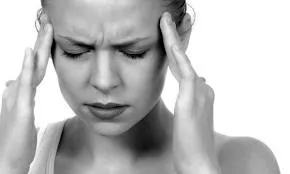
Your near sight glasses are proscribed
to provide clear vision from 6 metres to infinity. Since
the glasses are static, they will be 20 times out of
alignment if you use them for reading at 30 cm. If you
look at something 3 metres away they will be 50% or half
wrong. This fact is difficult to get around if you wear
glasses. At this point in time it is not possible to
construct glasses that vary their power as you change
from reading to looking out of the window. Your video
camera has the capability to do this by moving the lens
elements back and forth to keep your video in focus.
'Our eye is like a camera,'
says Associate Professor Katrina Schmid of the
school of optometry at Queensland University
of Technology (QUT). 'When you look at objects
from different distances you've got a little
lens in your eye and that changes shape so we
can see clearly at different distances. When
we look up close... the lens becomes fatter and
more curved. It's like a soft squishy bag of
protein so it can do that. But with age the lens
gets hardened... it just physically can't change
shape any more.'
Your ability to focus close
up starts to deteriorate from the age of 10,
but it usually only becomes noticeable after
about 40, which is when many people find themselves
going for an eye test and leaving with their
first pair of reading glasses. |
Importance
of the optic centre
The lenses in all pairs of glasses have
only one point of best vision - the optic centre. This
means that they are constructed as if you were always
looking through the dead centre of the lenses, with this
centre located directly in front of your eyes as you
look straight out in front of you. When you look through
the glasses and turn your eyes away from this centre,
the lenses become more like prisms. You have probably
seen this effect on photographs taken through wide angle
lenses. The edges of the image get distorted. This, along
with the fact that glasses also have some sort of frame,
encourages you to keep your eyes locked into the position
that gives best vision. A frequently used practice in
the attempt to control diverging eyes is the fitting
of strong plus lenses. This is a treatment that sadly
ends up driving the vision further downhill.

The optic centre also plays a role when
you use lenses for reading. Remember, your glasses are
prescribed with the intention of correcting your distance
vision. When you look at the horizon your eyes point
straight out through the optic centre of the glasses.
However, when you read you turn your eyes in and down
in order for your eyes to converge on your book. Unless
you wear special reading glasses, or have them incorporated
into your glasses, the optic centre of each lens will
be further apart than required. The result is additional
strain on your eyes, the more you read the greater the
damage.
If you wear near sight glasses whilst working
at a computer, they will be wrongly adjusted for both
reading at about 35 cm and the computer screen at 60
cm. This is a contributing factor to the way that computer
work affects the eyesight.
Could Reading
in dim light ruins your eyesight?
The fearful idea that reading in dim light could
ruin one’s
eyesight probably has its origins in the physiological experience
of eye strain. Suboptimal lighting can create a sensation of having
difficulty in focusing. It also decreases the rate of blinking
and leads to discomfort from drying, particularly in conditions
of voluntary squinting. The important counterpoint is that
these effects do not persist.
The majority consensus in ophthalmology,
as outlined in a collection of educational material
for patients, is that reading in dim
light does not damage your eyes Although it can cause eye
strain with multiple temporary negative effects, it is unlikely
to cause a permanent change on the function or structure of the
eyes. Even in patients with Sjögren’s syndrome
(an autoimmune disease that features inflammation in certain
glands of the body), decreased functional visual acuity associated
with strained reading improves when they stop reading.w35
One review article on myopia concludes that increased
use of one’s eyes, such as reading in dim light or holding
books too close to the face, could result in impaired ocular
growth
and refractive error. The primary evidence cited was epidemiological
evidence of the increased prevalence of myopia and the high incidence
of myopia in people with more academic experience.The author
notes that this hypothesis is just beginning to “gain scientific
credence.” In the past reading conditions involved even
less light, relying on candles or lanterns, so increased rates
of myopia over the past several centuries does not necessarily
support that dim reading conditions are to blame. In contrast
to that review, hundreds of online expert opinions conclude that
reading in low light does not hurt your eyes.w38 Source |
Wearing glasses is at best a compromise.
Everyone knows that the solution to clear vision is not
found in glasses. They cause many annoying inconveniences.
Just remembering where you've put them can drive you
to a point of frenzy! And how annoying it is when they
fog up when the humidity changes as you go from inside
to outside. They also get dirty, scratch, break etc.
at the most inopportune moments. "
Pinhole
glasses do they work?
Pinhole glasses are something of a phenomenon.
They allow anyone with blurry vision to see clearly -
instantly - without the need for corrective lenses.
You can test the concept right now. Make
a fist and put it up to one eye, with the other eye closed.
Open your fist just a tiny miniscule amount, just enough
to create a small hole to peep through. Amazingly, you
can now see clearly!
It's a bit miraculous, isn't it? What's
more, there is lots of anecdotal evidence to show that
wearing pinhole eyeglasses can improve your vision naturally
in just 15 minutes each day. While optometrists have
been reluctant to carry out the necessary clinical trials
to verify this, my personal experience leaves me with
little doubt that pinhole glasses can improve vision
naturally with daily use.
In fact, I believe that pinholes are an
excellent support to daily vision training,
Pinhole glasses, or stenopic glasses, are
an alternative to conventional eyeglasses to improve
vision. The shape and design are similar to normal frames,
but the difference is in the lenses. Instead of a lens,
pinhole glasses have a series of pinhole-size perforations
in a sheet of plastic, and each hole allows only a small
beam of light to enter the eye.
Pinhole glasses are worn like normal glasses.
Instead of transparent glass or plastic for lenses, opaque
black plastic "lenses" are used. Wearers see
through small holes (pinholes) in the black plastic.
To fully appreciate how pinhole glasses
work it is necessary to understand how the eye processes
light rays to form an image.
Hello Lynne,
I thought I would share with
you one of the benefits I have found while
using those pinhole glasses. After using them
for 3-5 minutes I notice that my eyes seem
to feel refreshed and cool,as if they have
just been bathed, instead of starting to feel
inflamed and itchy as is usal
Makes it so much easier to read for longer periods of time
RJ Texas |
How the eye
works:
Our ability to "see" starts when
light reflects off an object at which we are looking
and enters the eye. As it enters the eye, the light is
unfocused. The first step in seeing is to focus the light
rays onto the retina, which is the light sensitive layer
found inside the eye. Once the light is focused, it stimulates
cells to send millions of electrochemical impulses along
the optic nerve to the brain. The portion of the brain
at the back of the head (the visual cortex) interprets
the impulses, enabling us to see the object.
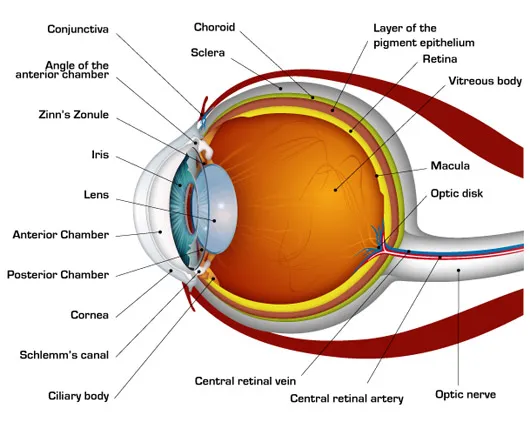
Click on picture for larger size
Light, refraction and
its importance.
Light entering the eye is first bent, or
refracted, by the cornea -- the clear window on the outer
front surface of the eyeball. The cornea provides most
of the eye's optical power or light-bending ability.
After the light passes through the cornea,
it is bent again -- to a more finely adjusted focus --
by the crystalline lens inside the eye. The lens focuses
the light on the retina. This is achieved by the ciliary
muscles in the eye changing the shape of the lens, bending
or flattening it to focus the light rays on the retina.
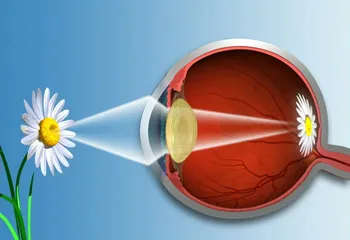
This adjustment in the lens, known as accommodation,
is necessary for bringing near and far objects into focus.
The process of bending light to produce a focused image
on the retina is called "refraction". Ideally,
the light is "refracted," or redirected, in
such a manner that the rays are focused into a precise
image on the retina.
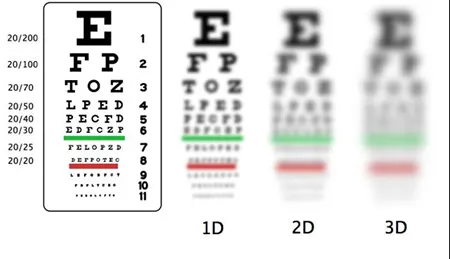
Click picture for larger eye chart
Hi there,
Well you did warn me! Even though you encouraged me to start
slowly with the glasses and use them for just a few minutes
each time I took the bull by the horns and did two hours
to start with. As you predicted the muscles in the back
of my eyes felt just like my legs when I first went back
to running and overextended them! However they quickly
settled down and I have really been aware of the improvement
in my eyesight so even when I forget to take any glasses
I can still read the menu in the restaurant.
LG Oregon |
Most vision problems occur because of an
error in how our eyes refract light. In nearsightedness
(myopia) the light rays form an image in front of the
retina. In farsightedness (hypermetropia), the rays focus
behind the retina. In astigmatism, the curvature of the
cornea is irregular, causing light rays to focus to more
than one place so that a single clear image cannot be
formed on the retina, resulting in blurred vision. As
we age, we find reading or performing close-up activities
more difficult. This condition is called presbyopia,
and results from the crystalline lens being less flexible,
and therefore less able to bend light.

Perfect vision in the unaided eye requires
the eye lens to focus light rays from diverse angles
into a single pinpoint directly on the retina at the
back of the eye. For sufferers of refractive eye disorders,
where the eye lens is too weak or the cornea or eyeball
is misshapen, divergent light rays become focused in
front of or behind the retina, casting an unfocused image
onto the retina itself. This unfocused area of light
is known as the 'blur circle'.

"Join
the Thousands of People Worldwide that have Helped
Their Vision Naturally!"

Millions of people have eye problems, ranging from slight
blurriness to near blindness. Most think there is nothing
they can do about it, but for some conditions, there
are methods that can help strengthen eye muscles.
How
do Pinhole Glasses Work?
Pinhole glasses are a natural
form of vision correction, that can never harm your
eyesight.
In contrast, glasses and contact
lenses only correct your vision superficially and are
known to make your vision worse over time.
Contrary to their name, pinhole eyeglasses
are not made of glass or corrective lenses. They are
simply black plastic (or metal) with holes punched through
where the lens would normally be.
 Pinholes
can be used to improve the vision of people who
have had damaging corneal surgery such as LASIK
and are
bothered by halos and "starbursts" around
lights. By creating a smaller pupil, pinholes can
reduce these disturbing problems.  People
old enough to need reading glasses
often can't use cheap, off-the-rack
reading glasses due to their astigmatism,
which is not corrected by such glasses.
Using ordinary pinhole glasses is one
obvious solution. An alternative is
to wear Snap-Ons over the reading glasses
to reduce the astigmatism. Both of
these alternatives are cheaper than
buying prescription reading glasses
with an astigmatic correction. The
above also applies when a significant
difference in the refraction of the
two eyes prevents using off-the-rack
reading glasses. People
old enough to need reading glasses
often can't use cheap, off-the-rack
reading glasses due to their astigmatism,
which is not corrected by such glasses.
Using ordinary pinhole glasses is one
obvious solution. An alternative is
to wear Snap-Ons over the reading glasses
to reduce the astigmatism. Both of
these alternatives are cheaper than
buying prescription reading glasses
with an astigmatic correction. The
above also applies when a significant
difference in the refraction of the
two eyes prevents using off-the-rack
reading glasses.
 Some
people who suffer from macular degeneration
have experienced an improvement in
their vision when using pinholes Some
people who suffer from macular degeneration
have experienced an improvement in
their vision when using pinholes
|
So, how do
pinhole glasses work?
In camera terms, pinhole glasses (also
called spectacles, eyeglasses and sunglasses) reduce
the effect of the eye's focusing errors by increasing
optical depth of field by reducing aperture size
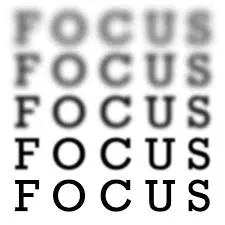
Pinhole glasses work based on the concept
that each hole only allows a narrow beam of light through.
This reduces the size of the optical spot not coming
into perfect focus on your retina and increases your
depth of field.
The lenses of pinhole glasses are perforated
with an array of equally spaced minute holes of approx
1mm - 1.5mm in diameter. In contrast the average diameter
of the pupil in normal daylight conditions is about 4mm.
Each pinhole allows only direct rays through, and it
is the amalgamation of these direct rays that make up
a concentrated beam of light that enters the pupil. When
this restricted light beam passes through the pupil and
into the eye lens, the effects of any refractive eye
disorders are reduced as the 'blur circle' on the retina
is proportionally smaller. The resulting visual image
is one of increased clarity, definition and brightness.
The unaided weak
eye without Pinhole Glasses |
|
In a weak eye, light rays
entering the eye's lens are not all focused
onto the same place on the retina. For example
rays a b f g, require more focusing by the
lens to hit the same plane as rays c d e,
which are nearer to the centre. Rays c d
e are usually always in focus, regardless
of the condition of the eye, and form a clear
image on the retina. This clear image is
flooded by the blurred image known as the "blur
circle" formed by rays a b f g. |
|
The unaided weak
eye with Pinhole Glasses |
|
When the pinhole lens is
used, only rays c d e are allowed to form
an image on the retina and no blur circle
is present to block the clear image. Consequently,
by using a lens with multiple pinholes, many
focused images form on the retina and a clear,
natural image is seen. Also, no effort is
required from the eye muscles, as the only
rays entering the eye are already in focus.
Hence there is a dramatic consequential,
relaxing effect. |
|
Some
advantages that pinholes have over prescription glasses:
 As
we get into our 40's and 50's and presbyopia (inability
to focus close) develops, pinholes provide a simple and
inexpensive solution for reading or other close work.
As
we get into our 40's and 50's and presbyopia (inability
to focus close) develops, pinholes provide a simple and
inexpensive solution for reading or other close work.
 Bifocals
or trifocals are designed to provide a clear image only
at fixed distances. Pinholes provide an improved image
at ALL distances. In many applications, such as alternating
between watching TV and reading, they can easily take
the place of those very expensive prescription lenses
that are so lucrative for the anti-consumer eye doctor/optical
industry alliance.
Bifocals
or trifocals are designed to provide a clear image only
at fixed distances. Pinholes provide an improved image
at ALL distances. In many applications, such as alternating
between watching TV and reading, they can easily take
the place of those very expensive prescription lenses
that are so lucrative for the anti-consumer eye doctor/optical
industry alliance.

 Multi-focal
lenses provide a continuously variable curve that is
supposed to give good vision at all distances. In reality,
the distortion on either side of the center line is
considerable and often too great for comfortable use.
Pinholes eliminate this problem.
Multi-focal
lenses provide a continuously variable curve that is
supposed to give good vision at all distances. In reality,
the distortion on either side of the center line is
considerable and often too great for comfortable use.
Pinholes eliminate this problem.
 There
is no need to continually throw away old glasses and
buy new, stronger ones. Unless the pinholes get broken,
they can be used an entire lifetime.
There
is no need to continually throw away old glasses and
buy new, stronger ones. Unless the pinholes get broken,
they can be used an entire lifetime.
 While
pinholes are not as cheap as off-the-rack reading glasses,
they are considerable cheaper than individual prescription
glasses. For example, a person who is a little nearsighted
but only needs clear distant vision for occasional
TV viewing would find pinholes a cheaper solution than
prescription glasses.
While
pinholes are not as cheap as off-the-rack reading glasses,
they are considerable cheaper than individual prescription
glasses. For example, a person who is a little nearsighted
but only needs clear distant vision for occasional
TV viewing would find pinholes a cheaper solution than
prescription glasses.
 Off-the-rack
reading glasses have the same lens power in each lens.
Some people find these cheap glasses unsuitable because
the refractive error in each eye is not the same. Pinholes
are ideal for such people because these glasses do
not require a similar refractive error in each eye.
Off-the-rack
reading glasses have the same lens power in each lens.
Some people find these cheap glasses unsuitable because
the refractive error in each eye is not the same. Pinholes
are ideal for such people because these glasses do
not require a similar refractive error in each eye.
 There
is a pincushion effect when looking through the edges
of prescription glasses. That is, straight lines appear
curved. This disturbing effect does not occur with
pinholes.
There
is a pincushion effect when looking through the edges
of prescription glasses. That is, straight lines appear
curved. This disturbing effect does not occur with
pinholes.
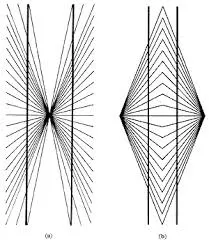
 When
you lay prescription glasses down improperly, they
can easily get scratched at the center of the lens,
the very area you have to look through. Scratching
pinholes has no effect on their performance.
When
you lay prescription glasses down improperly, they
can easily get scratched at the center of the lens,
the very area you have to look through. Scratching
pinholes has no effect on their performance.
 Pinholes
do not have to be cleaned of fingerprints and other
marks that affect vision.
Pinholes
do not have to be cleaned of fingerprints and other
marks that affect vision.
 Many
parents will not allow their children to use bifocals
to reduce the stress of close work because such glasses
are for "old people." Pinholes are an easier
thing to accept because they are the same for all ages.
Many
parents will not allow their children to use bifocals
to reduce the stress of close work because such glasses
are for "old people." Pinholes are an easier
thing to accept because they are the same for all ages.
 Many
people who have had corneal surgery find that their
night vision has permanently deteriorated. Glare is
a problem. They see halos and "starbursts" around
lights. Even in normal home lighting they have problems
so that they get in the habit of turning on as many
lights as possible in order to get a small pupil and
reduce the visual problems. Pinholes, either conventional
or Snap-ons, can deliver the same small pupil without
increasing the electric bill.
Many
people who have had corneal surgery find that their
night vision has permanently deteriorated. Glare is
a problem. They see halos and "starbursts" around
lights. Even in normal home lighting they have problems
so that they get in the habit of turning on as many
lights as possible in order to get a small pupil and
reduce the visual problems. Pinholes, either conventional
or Snap-ons, can deliver the same small pupil without
increasing the electric bill.
 Children
with special needs often use only their peripheral
vision, and pinhole glasses help them concentrate on
detail better. It has been found that the pinhole glasses
help improve acuity and central macular vision. One
nationwide organization that deals in child development
uses pinhole glasses on a regular basis for this purpose.
Children
with special needs often use only their peripheral
vision, and pinhole glasses help them concentrate on
detail better. It has been found that the pinhole glasses
help improve acuity and central macular vision. One
nationwide organization that deals in child development
uses pinhole glasses on a regular basis for this purpose.
The
fix that fails kids' eyes
23 November 2002
Andy Coghlan Michael Le Page
Magazine issue 2370
The standard prescription for correcting children's short sight actually
seems to make their eyes deteriorate faster. And it has been used routinely
for decades
MILLIONS of people worldwide may have worse eyesight and even be more
likely to go blind because of a long-held but misguided idea about how
to correct short-sightedness. A study intended to confirm the theory
has instead been stopped because the children's eyesight was getting
worse, New Scientist has learned.
For decades, many optometrists
have been routinely "undercorrecting" short-sightedness,
or myopia, when prescribing glasses or contact
lenses. "What was done was done with the
best of intentions," says optometrist Daniel
O'Leary of Anglia Polytechnic University in Cambridge,
England. Indeed, his study of 94 children in
Malaysia sought to prove the value of undercorrection.
Instead, it showed the opposite.
While the number of children involved
was small, amazingly it is the largest and most
rigorous study to date. "The study was meant
to run for three years but after two years, when
we found out we were making the children's eyes
The
complete article is 861 words long.
|
 Aniridia
is the complete or partial absence of the iris; polycoria
is having more than one pupil in a single iris; and
albinism is the lack of normal pigmentation. All
of these abnormalities may be aided with pinhole
lenses.
Aniridia
is the complete or partial absence of the iris; polycoria
is having more than one pupil in a single iris; and
albinism is the lack of normal pigmentation. All
of these abnormalities may be aided with pinhole
lenses.
 In
cases of retinal separation, unnecessary motion of
the eyeballs should be avoided. This can be accomplished
by blocking all but the central pinholes, forcing
the user to turn the head rather than the eyes
In
cases of retinal separation, unnecessary motion of
the eyeballs should be avoided. This can be accomplished
by blocking all but the central pinholes, forcing
the user to turn the head rather than the eyes
Good day
to you two,
What a hoot. I have just come
back from the optomertrist after having my
eyes checked and he is STILL scratching his
head! He does not understand how my eyesight
seems to be imptoviong at the ripe old age
of 77 and he definitely was not interested
in investigating my pinhole glasses !!
J D Montana |
How did you say they
worked?
Pinhole glasses are based on the principle of
natural reflexes as the same effect is achieved when
you squint to try and see more clearly. Your eyelids
close around the top and bottom of your eyes, filtering
out light rays reaching your pupil from these angles.
Only light from your central area of vision and to the
left and right sides can now enter your eye. The image
you see is often sharper with a greater depth of resolution,
and is generally brighter as there is a narrower range
of light levels to contrast against each other. Wearing
pinhole glasses is of course much less stressful on the
eye than squinting, and is far more efficient at blocking
extraneous light rays to produce a sharper and brighter
image on your eye.
Just look through any pin-hole and you'll
see what they mean. When you do this, blurred images
become focused. This is because the amount of peripheral
light rays (which are responsible for blurring) is reduced.
With appropriately spaced multiple pin-holes, you'll
get clear straight vision without the difficulty of concentrating
on a single hole. Regular use of these special pinhole
glasses helps exercise eye muscles and helps eyes relax
at the end of a tiring day and thus has a beneficial
effect. Particularly useful for those who spend a great
deal of time looking at computer and/or TV screens, Pinhole
Glasses help retrain your eye muscles, just as other
forms of exercise retrain muscles elsewhere.More
Info Here

Vision improvement
For people who have been diagnosed with
myopia, hyperopia, presbyopia, astigmatism or cataracts,
pinhole glasses offer instant relief through better vision.
You'll really notice the difference when focusing in
the middle to long distance, such as when watching TV
or reading from a classroom blackboard. Users of pinhole
glasses report almost perfect vision and have little
difficulty reading words or seeing definition in a TV
image WITHOUT THEIR PRESCRIPTION SPECTACLES.
What are Pinhole Glasses
For?
1. Prevent Computer Vision Syndrome -
if you use computers a lot you will recognize the signs:
eye strain, dry eyes, fatigue, headache, blurry vision
and double vision. This is all down to intense near point
stress. Computer glasses can reduce the glare from the
monitor, help relax the eyes, increase depth of field,
and increase your natural focusing power (also known
as accommodation).
• Because of the way pinholes minimize
light to the eye, they work well as sunglasses or for
extremely bright conditions. They also work well in reducing
the visual stress of lengthy computer work
2. Relieve Eye Strain and Improve Your
Vision - when I wear pinhole eyeglasses, I get a clear
long distance focus without any eye strain. This is very
supportive for reducing myopia. In fact, some users report
that wearing pinhole glasses for just 15 minutes a day
can noticeably improve your vision in 4 weeks. If you
have farsightedness, you need simply read and write with
pinholes on, while nearsighted people need just sit back
and watch TV wearing pinholes.
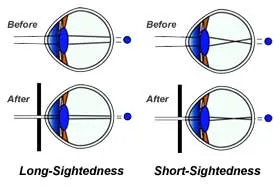
Cataracts People
with cataracts often see better through pinholes. A cataract
doesn't allow light to enter the eye properly. Pinholes
often improve the vision even with the existence of the
cataracts.
Specialty Glasses
If any person is chronically myopic and
is diagnosed with more than 6 diopters of near-sightedness,
then pinhole glasses may not improve their vision significantly
due to excessive problems with diffraction.
"When used for reading or other close
work, pinholes reduce the amount of accommodation or
focusing power that the eye must use to see clearly.
There is an abundant amount of research that points the
finger at excessive accommodation as the cause of acquired
myopia.
It is clear that anything that can reduce
this accommodative effort, including pinhole glasses,
is a useful weapon in retaining good vision. It is for
this reason, and the fact that those in the optical business
want nothing to do with them, that we have decided to
promote the use of pinholes on this website. These glasses
could be a major tool in preventing myopia.
Its well proven Pinhole glasses make it
easier to read and do other close-up work. They easily
take the place of expensive prescriptions glasses, and
they are durable enough to last a lifetime.
Hi there,
Well you did warn me! Even though you encouraged me to start
slowly with the glasses and use them for just a few minutes
each time I took the bull by the horns and did two hours
to start with. As you predicted the muscles in the back
of my eyes felt just like my legs when I first went back
to running and overextended them! However they quickly
settled down and I have really been aware of the improvement
in my eyesight so even when I forget to take any glasses
I can still read the menu in the restaurant.
LG Oregon |
AMAZING EFFECT EXPERIENCED BY THE WEARERS
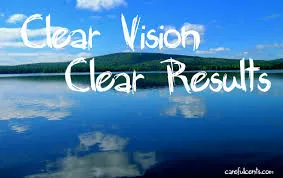
USING
YOUR PINHOLE GLASSES
Pinholes are best worn when watching TV or reading. When
reading always make sure adequate lighting is supplied.
As you look through Pinholes some light is cut out.
Pinholes are also excellent for computer operators.
Computer screens tire and strain eyes rapidly, Pinholes,
allow your eyes to relax.
Your eyes may take a little while to adjust to Pinholes,
but in a short period your eyes will not notice that
they focus through these tiny holes. That is why watching
TV is ideal, you forget very quickly that you are wearing
them.
Pinholes should be
worn for at least 15 mins a day, or as often as possible.
Never wear your Pinholes when driving or doing any activity
where sideways vision is required. Do not use as sun
glasses. Always make sure your Pinholes are clean and
check no holes are blocked, it is very important to have
complete vision
IN THE FIRST PLACE
You will see objects clearly through the pinholes drilled in the lenses. Even
those who have near-sightedness, farisightedness, astigmatism, or amblyopia
can see objects clearly through the small holes. In this case, the eyeball
muscles of the wearer get normalized by themselves and the focus of the eyeball(the
crystalline lens) is adjusted. The pinholes are small plain holes.
AFTER A SHORT PERIOD
If you look at things without the glasses after wearing them for about half
an hour, you will be surprised that you can clearly recognize even very small
letters. (However, you will be soon again unable to see distinctly).
AFTER A SHORT TIME
If you persist in wearing these glasses only a couple of hours a day while
reading books or newspapers, or watching TV, and your eye problems are not
hereditary, you will succeed in your sight-recovering exercise, and the eyeball
muscles and cystalline lenses will be normalized.(You may not need glasses
at all)
REMARKS OF
AMERICAN DOCTORS ON THE INVENTION
Dr. Janet Goodrich(a distinguished eye-sight-correcting
specialist)
" People with both close and distant blur and astigmatism are able to use
micohole sight correctors."
Dr. David Michael(author of Visual Optics and Refraction)
" Microholes reduce aberrations and light scattering, isolate a favorable
area of the damaged cornea and increase depth of focus."
Dr. Norman Bies(author of Correction of Subnormal Vision)
" The longer depth of focus obtained through microholes is well established
--- patients enjoy a substantial increase in reading distance.
Myopia (short sightedness)
Hyperopia (long sightedness)
Presbyopia (age-related reduced range of focus)
Astigmatism
Cataracts
Eye strain (from computer screens)
NOTE:If you have more than 6 diopters of
myopia, you will probably not find pinholes useful since
they cannot overcome so much blur. Pinhole glasses are
intended to be used only when sitting or standing still.
They should not be used when driving
a vehicle.

